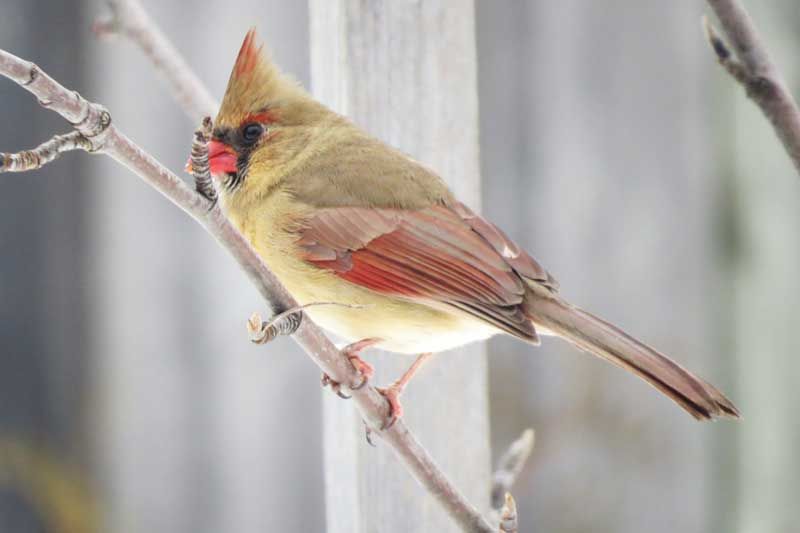Lorraine Julien | Feb 10, 2016
Almost anyone can identify a Cardinal. This medium-sized red songbird is characterized by a unique crest they can move at will, a black mask on the face and a short, cone-shaped bill. Although known for their vivid red colour, only males have the super red feathers. The female is very pretty, though not as striking as the male. She has grayish shades through her body and duller warm red wings and tail, with a sharp crest just like her mate.
Once primarily a southern bird, the Cardinal has steadily extended its range northward since the early 20th century. For many years, they’ve been regular inhabitants of southern Ontario as well as the Atlantic provinces. Since Cardinals do not migrate, we are lucky to have this beautiful creature year-round. I am lucky to have a resident pair that visits my feeder daily to munch on their favourite black-oiled sunflower seeds.
Cardinals not only mate for life, they remain together throughout the year. Their lifespan is about 16 years. As long as the leaves are off the trees, it’s pretty easy to spot them. Even in the evergreens, their colours are so brilliant, they show up like Christmas ornaments.
As spring gets closer, the Cardinals become more vocal. Both male and female have a wide range of musical notes and sometimes sit side by side at the top of a tall tree singing their hearts out. It is rare to see a Cardinal without seeing its mate. In fact, I’ve noticed that if the female is at the feeder, the male is usually in a nearby tree keeping a close eye out for predators or intruders. He is very skittish so any photographs I’ve taken have been through the kitchen windows.
Once late winter or early spring arrives, a nest site is chosen. The female weaves a deep cup of bark strips, rootlets and grass, and lines it with fine grasses or hair. The male feeds her during the two weeks that the 3 or 4 eggs are incubated. The fledglings may be fed by both parents – grasshoppers, beetles, grubs, caterpillars and other insects. So strong is the male’s instinct to feed young birds that he sometimes stuffs food down the throats of nestlings of other species! The youngsters are dull and brown with black beaks until fall when they molt and, in their first winter plumage, they look like their parents.
There are a wide variety of predators including hawks, owls, shrikes and falcons. Predators of chicks and eggs include milk snakes, blue jays, eastern gray squirrel, eastern chipmunk and domestic cats.
A male Cardinal will fiercely defend his territory. Rivals are warded off with angry cries. If an intruder persists, the Cardinal darts out to attack. If he sees his reflection in a mirror or window, he will keep pecking away relentlessly at the supposed intruder! Earlier in the winter, I noticed a Cardinal without tail feathers and I now suspect that he was probably attacked by the male that is always in this area.
The Cardinal does not molt so they are colourful year-round. Thanks to its expansion northward, more and more people find the drab winter days brightened by the fiery beauty and vibrant song of the Northern Cardinal.
Please send your observations to Lorraine Julien at This email address is being protected from spambots. You need JavaScript enabled to view it. or Steve Blight at This email address is being protected from spambots. You need JavaScript enabled to view it.
More Stories
- No Winner Yet in Catch The Ace But Fundraising Target Met
- South Frontenac Food Bank Opens Second Location in Battersea
- Sharbot Lake Pentecostal Church Anniversary - 1925-2025
- Frontenac Holistic Health Fair - September 20 At Storrington Centre
- Odd Year For Real Estate - But Sales Are Steady Year Over Year
- 193rd Kingston Fall Fair
- Kim Phuc - the Napalm Girl - To Visit Flinton In November
- South Frontenac Council - September 2
- Sticker Shock - EV Charging Station To Cost North Frontenac Township
- 30th Anniversary Verona Car Show

